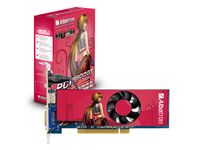Albatron Unveils GeForce 8-series Graphics Cards For PCI Slots
Albatron Technology has unveiled three new Nvidia GeForce 8-series graphics cards that use the practically outdated PCI slot. While the appeal of the PCI8600GT-256X, the PCI8500GT-256X and the PCI8400GS-256 may not be obvious for anyone who has a PCI Express or even AGP slot on their motherboard, there are still quite a few systems (particularly small form factor or HTPC ones) where expansion options are limited, creating an niche market for these cards.
More here at Digitimes.
Get Tom's Hardware's best news and in-depth reviews, straight to your inbox.

Wolfgang Gruener is an experienced professional in digital strategy and content, specializing in web strategy, content architecture, user experience, and applying AI in content operations within the insurtech industry. His previous roles include Director, Digital Strategy and Content Experience at American Eagle, Managing Editor at TG Daily, and contributing to publications like Tom's Guide and Tom's Hardware.
-
nvalhalla So they'll make an 8 series for PCI but not AGP? I'm really curious how much the PCI bus cripples these things. The benchmarks I've seen so far have the 8500 only slightly slower than the 8600, so I'm sure the PCI bus is really hurting them.Reply -
njalterio Outdated PCI slot = girly pink packaging and sticker?Reply
Is Albatron suggesting that mainly women use older computers? lol -
blackened144 Are those slower 8 series even fast enough to saturate the PCI bus? Im sure I could look that up myself, but Im just too lazy..Reply -
ROFL!! With the BUS limitations I'd be shocked if this card can do 30 fps at 640 X 480. I'd love to see some benchies just for the fun of it.Reply
-
I hate to double post but just for everyone's information the PCI can only 133megs or 266 if it's 64 bit PCI (the 32 bit is much more comman). Not to mention it's sharded with the sound, network, and possibly some others, not USB though, that's serial.Reply
-
blackened144 The problem with "ALOT of PCI slots" is that the bandwidth is shared between them all. So if one card can fully saturate the PCI bus, then you can have 1 card in each slot, but the total throughput for all the cards will remain the same. EZG, most modern motherboards have network, sound, etc running over PCI Express to the south bridge and the PCI bus is connected by itself directly to the south bridge giving full bandwidth to the PCI bus. That wouldnt matter in this case though as its still most likely too slow to matter.Reply -
Frast These cards do have a purpose. They can be implemented in systems that need multiple monitor support for software like doctors who work at home with imaging data. Not everyone uses video for games! :)Reply -
@FrastReply
Yep... there's a sort of mini revolution going on in medical imaging... the bandwidth isn't as important since the FPS doesn't need to be perfectly smooth. They are using them like little supercomputers for parallel processing and simulations.
Since it's processor bound as opposed to IO bound (Typically not as many textures) it can be effective on the PCI bus. You made me remember this: http://www.rt-image.com/content=8204J05C485EA486405698764488A0441
